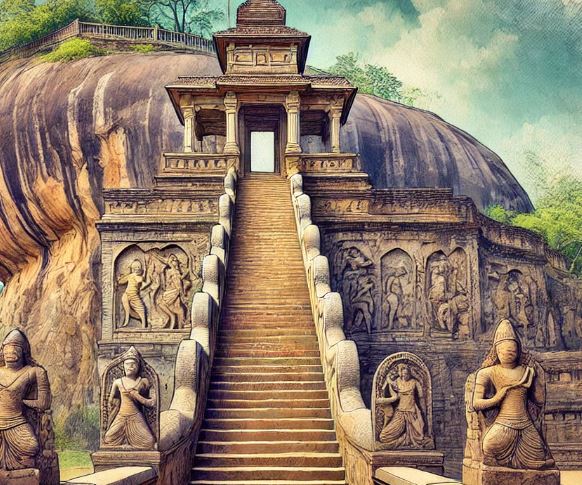Yapahuwa: Exploring the Ancient Rock Fortress of Sri Lanka
By Bhanuka – eLanka

Yapahuwa is one of Sri Lanka’s most intriguing ancient sites, known for its majestic rock fortress and rich history as a former capital of the island. Nestled in the North Western Province, about 150 kilometers northeast of Colombo, Yapahuwa offers a unique glimpse into the country’s medieval past. The site, though lesser-known compared to other ancient capitals like Anuradhapura and Polonnaruwa, is a treasure trove of history, architecture, and culture.
Historical Background
Yapahuwa was the capital of Sri Lanka for a brief period during the 13th century, serving as a royal residence and military stronghold. The fortress was built by King Bhuvanaikabahu I (1273-1284) to protect the Sacred Tooth Relic of the Buddha, which symbolized the legitimacy of the king’s rule. This strategic location on a 90-meter-high rock provided natural defenses against invaders, particularly from South India.
After the fall of Yapahuwa to invaders in 1284, the Sacred Tooth Relic was stolen and taken to South India, marking the decline of Yapahuwa as a royal city. Although its glory days as a capital were short-lived, the remnants of this ancient citadel still stand, showcasing the remarkable artistry and architectural prowess of that era.
Architectural Highlights
Yapahuwa is renowned for its impressive rock fortress, which is similar in design to the more famous Sigiriya. The fortress complex includes a series of stone steps, beautifully carved guard stones, and a majestic ornamental gateway that leads up to the summit of the rock.
1. The Grand Staircase
The most striking feature of Yapahuwa is its grand staircase, adorned with intricate carvings of dancers, musicians, and mythical creatures. The staircase, with its steep, ornate steps, is a masterpiece of medieval Sri Lankan art, reflecting the artistic and cultural influences of the time. At the top of the staircase is an elegant stone doorway that once led to the Tooth Relic Temple, a symbol of the site’s religious significance.
2. The Temple of the Tooth Relic
Though the temple that once housed the Sacred Tooth Relic is now in ruins, its foundations and remaining stone carvings indicate its former grandeur. This temple was once one of the most important religious sites in Sri Lanka, drawing pilgrims and visitors from across the kingdom.
3. The Lion Carvings
Yapahuwa is famous for its lion carvings, which are considered some of the finest examples of Sinhalese sculpture. These carvings, which once flanked the entrance to the temple, are beautifully crafted and exude a sense of regal authority, symbolizing protection and strength.
4. Ancient Stupas and Monasteries
The fortress complex also includes the remains of ancient stupas, monasteries, and rock caves that were once used by Buddhist monks. These structures provide insights into the religious life that flourished in Yapahuwa during its time as a royal city.
Exploring Yapahuwa Today
Today, Yapahuwa is a popular archaeological site that attracts both local and international visitors. The serene environment, combined with the historical allure of the ruins, makes it a fascinating destination for history enthusiasts, photographers, and those seeking to explore Sri Lanka’s cultural heritage.
Visitors can climb the steep steps of the rock fortress to reach the summit, where breathtaking views of the surrounding countryside await. The climb is moderately challenging but rewarding, offering a sense of connection to the ancient inhabitants who once called this fortress home.
Practical Information for Visitors
- Location: Yapahuwa is located in the Kurunegala District, about a 2.5-hour drive from Colombo.
- Opening Hours: The site is open daily from 8:00 AM to 6:00 PM.
- Entrance Fee: A small entrance fee is charged for foreign visitors, contributing to the maintenance and preservation of the site.
- Best Time to Visit: The best time to visit Yapahuwa is during the early morning or late afternoon when the temperatures are cooler and the light is ideal for photography.
Conclusion
Yapahuwa may not be as widely known as other ancient capitals of Sri Lanka, but it offers a unique and enriching experience for those who visit. The rock fortress, with its grand staircase, stunning carvings, and historical significance, stands as a testament to the island’s rich cultural and architectural heritage. A visit to Yapahuwa is not just a journey into the past; it’s an opportunity to witness the enduring legacy of Sri Lanka’s medieval history.






















